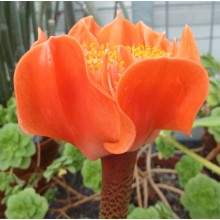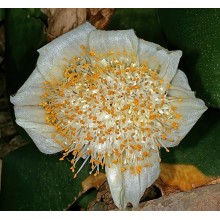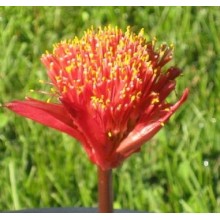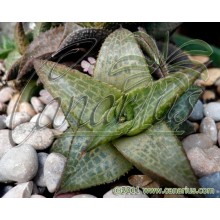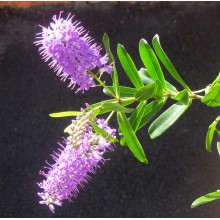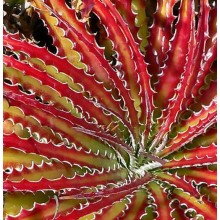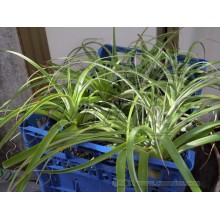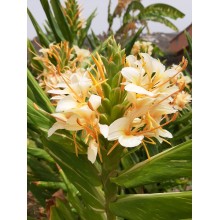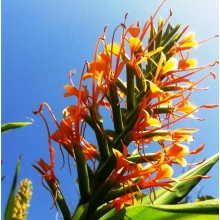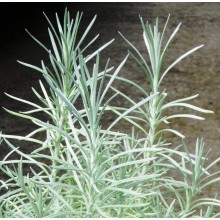Exotics There are 1155 products.

Exotic plants are species from other parts of the world, and they usually have ornamental qualities: a lush foliage, colorful flowers, unusual shapes... Here you can find a great variety of exotic plants: from Bromeliads and Heliconias, to pamls and houseplants.
Exotic plants do not have a particular use. Collectors buy this kind of plants for their rarity, for indoor or outdoor decoration, depending on their features.
Subcategories
-
Bromeliads
Bromeliaceae is a large family of herbaceous plants native to the Americas. Just like many orchids, they naturally grow on tree branches or above rocks and cliffs. Bromeliads are highly appreciated because of their incredible colours and their ease of growth in pots.
We offer a fine selection of bromeliads that are never available through garden centres in Europe. Large scale distribution mostly sells green, thin-leaved hybrids. Our shop keeps an ever-increasing offer of the species with the toughest and most colourful leaves, better adapted to hot and cold conditions of outdoor life. All our bromeliads are shipped as bare root “pups”. These are the robust basal suckers produced after blooming. Bromeliads travel amazingly well in the mail and they are also cheap to ship. Our robust pups will often bloom in less than one year.
-
Aroids
The botanical family Araceae, is popularly called Aroids and includes about 3750 species. It abounds in the tropics and holds the most spectacular diversity of leaf shapes and textures. The large genera Philodendron and Anthurium are symbols of the American rainforests and they are widely cultivated as house plants. Smaller genera Monstera, Rhaphidophora and Thaumatophyllum are similar in cultivation. Some are truly exotic, with velvety leaves and bright veins, so collectors can build up a tropical forest in their apartments.
The genus Alocasia builds huge leaves, often called elephant-ears and make bold garden centerpieces. Colocasia esculenta is an important food crop, known as taro. It was domesticated in Asia and the Pacific and comes in many cultivars.
Some genera are not evergreen and rest for months (mostly in winter) as underground corms. This is the case of Amorphophallus, a genus also known for its large, unusual and often stinky flowers. -
Cycads
Cycads are a group of primitive plants, similar in shape to palms and ferns. They are gymnosperms, in the order Cycadales, so they do not produce flowers, but they do grow cones, like pines and other conifers. They are found across much of the warmer parts of the world and they are often endangered and restricted to inaccessible areas. Some grow in cold mountainous areas and tolerate frost and snow.
Most Cycad species perform well in the garden and make excellent potted plants. Some have become popular ornamentals, while others are very rare and are protected by law as CITES species. Our cycads are established plants grown from seed, two or more years old, grown in tall pots. All plants are legally produced. We offer the largest selection in Europe of the genus Cycas, with many new cold-hardy chinese species. Visit the cycad section in our blog and learn why our cycads have an excellent quality.
-
Ferns
In ornamental plants, we can discover a popular sort of species: Ferns. It could be say that Ferns have spent more time on Earth than humans. Due to its rich shape and its elegance, Ferns have been become in appreciated indoor plant both on a table and hanging on the wall.
It is worth to distinguish the large leaves of these plants. Most of the ferns are from tropical areas around the world with high humidity. You can find a great variety on our online store.
-
Heliconia & Gingers
Heliconia is a genus of about 200 species known for its quintessentially tropical inflorescences and large, exotic green leaves. Blooms are incredibly colourful and often pollinated by hummingbirds.
Gingers are a family, Zingiberaceae, with about 1.300 species and some are well-known ornamentals, spices and medicines.Heliconias and gingers are tropical herbaceous plants with underground stem. Many species are sensitive to frost, but some originate in colder habitats and will do well in a Mediterranean climate. A few also tolerate snow and frost. We ship healthy field-grown rhizomes with at least two active growing points.
-
Bulbs
Bulbs are modified stems that grow underground and function as food storage organs during dormancy. They are widespread in all types of seasonal areas of the world. Some of the most spectacular ones occur in deserts and produce showy flowers at the start or the end of the rainy season. From tulips to onions, hippeastrums or lilies, they are all monocotyledons, except the genus Oxalis, which is the only dicot that produces true bulbs. -
Indoor Plants
This is our selection of plants that can live in your home, as "indoor plants". These hard-to-find species are all very different but they can all be grown in your home. Some can take very low light and some others might need to receive some sun from a window. Palms, bromeliads, cordylines and aspidistras should never dry out. On the other hand, Sansevierias, Hoyas and Rhipsalis need less water and can even take drought.
-
Plumerias
Tropical trees, native to warm tropical areas of the Caribbean, Central America and Northern South America. Plumerias are famous for their gorgeous flowers and come in a wide range of colors, like white, yellow and pink, as we can see in the picture. All of them produce a wonderful perfume scent.
Plumerias are easy to grow up, regardless of the region where you live. They are small trees, 2-10 m tall, but they will grow and bloom in relatively small pots for decades. They are frost-tender but they shed their leaves and rest until late April, so they are easy to winter indoors.
We grow strong mother plants in our fields to produce the best thick, apical cuttings. Then we root them for almost one year before selling the plant. Our plumerias can bloom in less than one year, if cared properly. -
Fragrant Plants
Fragrant Plants have been an important part of the medical and cultural stories of China, India, the Far East, the Middle East, Central America and Northern Native Americans. They are perfect for perfuming, both your garden and your home.
These plants have certain very specific demands when it comes to sunlight, temperature and humidity. Fragrant Plants are famous for the scent of its flowers and foliage.
-
Palms
The palm family, Arecaceae or Palmae, includes about 2.400 species, native to warm climates of the world, ranging from delicate tropical species to cold hardy palms. Some palms can be planted outdoors in Central Europe and stand hard freezes, well below -10 ºC (14 F). Those who live in Mediterranean countries can grow a larger number of species outdoors. Some growers in coastal Southern Europe are now raising outdoor collections of palms containing more than 100 species.
Canarius will only ship robust palms, grown in small pots to reduce shipping costs and handling problems. So transplant them to larger pots shortly after you receive the package. Be prepared to give them the best. Some palms can take snow, some can live indoors or in pots, and some are very tropical. Just choose one that can thrive in your conditions.
What palms can grow in your area? Read our list of Cold Resistant Palms for Europe. Visit Canarius blog and learn more about our palms. You will see pictures from the nurseries: different types of New Zealand Palms, Bottle Palms with superior root quality.
-
Showy flowers
Showy Flowers; this type of flowers attract animals and makes possible the pollination. They are of essential importance in parks and gardens. The color makes them showier. The attractive of the Showy Flowers remains while the plant is alive and its beauty resides in its leaves that are brightly colored.
These flowers add beauty and color to the garden.You can find in our online store a variety of them such as: Clivia x Cyrtanthiflora, Convolvulus cneorum, Heliconia stricta 'Dwarf Jamaican' among others.
-
Other exotics
Here you will find some exotic flower and foliage species that have not been yet placed in their own category. Some are small herbaceous plants, while some are large trees. You will find acalyphas, cordylines, hoyas, pandanus, plumerias and others, including uncommon plants. Day by day we will add more and more interesting items.
-
Carnivorous Plants
All over the planet except Antarctica, plants have evolved to attract, trap, and digest animal prey, with the help of enzymes or bacteria that extract nutrients. There are about 600 species of carnivores, contained in 12 genera. Most live in swampy areas and many of them are true beauties. There are three main types of trap: folding leaves, gluey trichomes, and pitcher-like pitfall traps. -
Aquatic plants
We are proud to offer our selection of exotic aquatic plants, which can be grown inside or by the garden pond, We offer a growing number of species uitable for water bodies or all types of wet areas. Many are showy ornamentals such as the different cultivars of tropical waterlilies and dwarf lotus, and some species are also edible, such as the Asian water chestnut or the Water spinach.
-
Haemanthus coccineus
Haemanthus coccineus
These bulbs are now about five years old, sown from seeds in 2019.
48,50 € -
Haemanthus deformis
Haemanthus deformis
Evergreen haemanthus with leaves laying on the ground, not flat but with some "bumps", which ar typical of this species. White brush-like inflorescences. These bulbs are now about three years old, sown from seeds in 2018. They belong to the populations found in KZN
37,00 € -
Haemanthus namaquensis
Haemanthus namaquensis
It is native in southern Namibia and north-western South Africa. The bulb can grow to five or even 13 centimetres in diameter, the entire plant to 20 centimetres in height. The flowers are scarlet. This is a winter-grower.
118,50 € -
Haemanthus pauculifolius
Haemanthus pauculifolius
This evergreen bulb is closely related to the widespread Haemanthus albiflos and it is just as easy in cultivation.
30,50 € -
Haworthia venosa
Haworthia venosa
Large, Branched, Cont.= 8,5 cm. - Triangular leaves with extraordinary patterns. A paler network of veins contrasts over a paler, translucent background. A slowly proliferous species that can grow indoors in bright windowsill conditions.
11,20 € -
Hechtia texensis
Hechtia texensis
A small, colourful frost-hardy terrestrial bromeliad. A gem for collectors!
28,20 € -
Hechtia tillandsioides
Hechtia tillandsioides
This is an unusual and elegant terrestrial bromeliad with spineless silvery leaves. Leaves are soft and velvety to touch. Established plants will bloom with huge "sprays" of pink flowers. Hechtia tillandsioides is native to Mexico (States of Hidalgo and Mexico). It takes frost and feels at home in Mediterranean climates !
21,50 € -
Hedychium coccineum 'Tara'
Hedychium coccineum 'Tara'
Cool-hardy ginger, with a particularly beautiful dense inflorescence, consisting of many, attractive, delicately scented orange-red flowers with striking stamens. Growth is quite upright and an adult clump can reach up to 2 m in height.
16,38 € 18,20 €Reduced price! -
Helichrysum Italicum
Helichrysum Italicum
Helichrysum italicum is a flowering plant of the daisy family Asteraceae. It is sometimes called false curry plant. It grows on dry, rocky or sandy ground around the Mediterranean. The stems are woody at the base and can reach 60 cm or more in height. The clusters of yellow flowers are produced in Summer, they retain their colour after picking and are...
12,00 € -
Heliconia aurantiaca
Heliconia aurantiaca
Small sized, cool-growing heliconia, from mid-elevations in Central America. It makes a neat shrub of compact erect stemps, up to 1-1,5 tall with olive-green leaves and bright yellow inflorescence. It is a favorite ornamental for conservatories, for its small and neat shape and not demanding heat.
28,60 € -
Heliconia bihai 'Lobster Claw One'
Heliconia bihai 'Lobster Claw One'
Magnificent ornamental heliconia, native to the rainforests of the Caribbean, and Northern South America. It produces rich red bracts with yellow-green lips in summer and grows to 2,5-3 m tall. "Lobster Claw One" is a classic selected clone of Heliconia bihai with deep red bracts.
25,80 € -
Heliconia bourgaeana
Heliconia bourgaeana
This hard to find species is an excellent garden subject, suitable to non-tropical climates. It blooms in April to August in the Canary Islands. Bracts are solid, glossy purplish red, with bright yellow flowers inside.
48,00 € -
Heliconia caribaea 'Red'
Heliconia caribaea 'Red'
Classic, deep-red clone of Heliconia caribaea, which is one of the best and easiest of all heliconias. lt blooms in June-August, at 2-4 m in height. This species is pectacular in the garden and spectacular as a cut flower.
43,00 € -
Heliconia caribaea 'Yellow'
Heliconia caribaea 'Yellow'
Heliconia caribaea is usually red in colour, but this clone has dark yellow blooms. This species is one of the best and easiest of all heliconias. Full sun keeps it compact and full of blooms.
48,20 € -
Heliconia collinsiana
Heliconia collinsiana
Great species, from the mountains of Central America, good for cool subtropical gardens. It is a strong grower, with spectacular pink pendant inflorescences. Leaves are shiny green above and waxy white below. New sprouts are started in March and bloom late, in September-November.
34,17 € 40,20 €Reduced price! -
Heliconia griggsiana
Heliconia griggsiana
Leaves are wide, purple-maroon beneath. Inflorescences are pendant, with variable shades of red, yellow, green and purple. This Heliconia is a magnificent beauty, good for subtropical climates. It comes from Colombia and Ecuador, at 800 - 2200 m elevation.
49,20 € -
Heliconia indica 'Spectabilis' - Rooted Plant!
Heliconia indica 'Spectabilis' - Rooted Plant!
Spectacular red-leaved Heliconia, with compact upright growth. Blooms are not as showy as in other heliconias but leaves have incredible golden-reddish colours, showing green only in full shade. The classic bold foliage of tropical Asian gardens.
76,30 € -
Heliconia indica 'Striata'
Heliconia indica 'Striata'
Outstanding heliconia with ornamental foliage and dense, upright habit. Most heliconias are from tropical America and only a handful of them is from the Pacific islands. Heliconia indica is one of them and 'Striata' is a supreme striped clone, selected in ancient times somewhere in Melanesia.
78,00 €
At the moment there are few products in this category Exotics





























